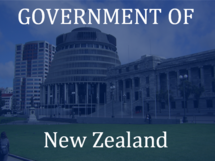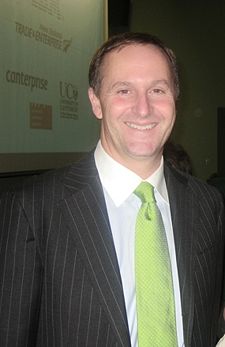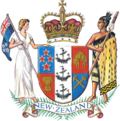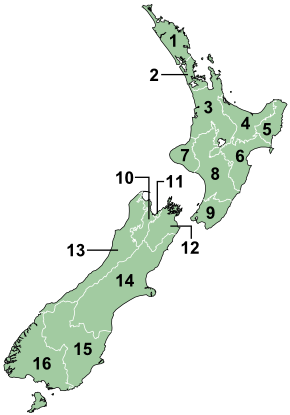Politics of New Zealand
| New Zealand | |
 This article is part of the series: |
|
|
|
|
|
Executive (The Crown)
Elections
General
|
|
|
Other countries · Atlas |
|
The politics of New Zealand takes place in a framework of a parliamentary representative democratic monarchy. The basic system is closely patterned on that of the Westminster System, although a number of significant modifications have been made. The head of state is Queen Elizabeth II, but actual government is conducted by a Prime Minister and Cabinet drawn from an elected Parliament.
New Zealand was the first country in the world in which all the highest offices were occupied by women, between March 2005 and August 2006: the Sovereign Queen Elizabeth II of New Zealand, Governor-General Dame Silvia Cartwright, Prime Minister Helen Clark, Speaker of the New Zealand House of Representatives Margaret Wilson and Chief Justice Dame Sian Elias.
Contents |
Constitution
New Zealand has no formal, written constitution; the constitutional framework consists of a mixture of various documents (including certain acts of the United Kingdom and New Zealand Parliaments), the Treaty of Waitangi and constitutional conventions. Most constitutional provisions became consolidated into the Constitution Act 1986. There have, at times, been proposals for a formal constitution, but there have not yet been any serious moves to adopt one.
Monarchy
New Zealand's head of state is the Queen of New Zealand, currently Elizabeth II. The New Zealand monarchy has been distinct from the British monarchy since the New Zealand Royal Titles Act of 1953, and all Elizabeth II's official business in New Zealand is conducted in the name of the Queen of New Zealand, not the Queen of the United Kingdom. In practice, the functions of the monarchy are conducted by a Governor General, appointed by the monarch on the advice of the Prime Minister. Under Letters Patent regulating the office of Governor General, which are granted by the Queen on the advice of the Prime Minister, when there is a vacancy in the office of Governor General, several of the duties of the said office are exercised by a caretaker, known as the Administrator of the Government. As of 2007[update], the Governor General is Anand Satyanand.
- See also: Republicanism in New Zealand
Executive

The Governor-General has the power to appoint and dismiss Prime Ministers and to dissolve Parliament. The Governor-General also chairs the Executive Council, which is a formal committee consisting of all ministers of the Crown. Members of the Executive Council are required to be Members of Parliament, and most are also in Cabinet. Cabinet is the most senior policy-making body and is led by the Prime Minister, who is also, by convention, the Parliamentary leader of the governing party or coalition.
The New Zealand Cabinet is responsible to New Zealand Parliament. All Cabinet Ministers must be Members of Parliament (MPs) and are collectively responsible to it.
| Office | Name | Party | Since |
|---|---|---|---|
| Queen | Elizabeth II | 6 February 1952 | |
| Governor-General | Anand Satyanand | 23 August 2006 | |
| Prime Minister | John Key | National | 19 November 2008 |
The current Prime Minister is John Key, leader of the National Party. His term began on 19 November 2008, replacing the outgoing Prime Minister Helen Clark. The Leader of the Opposition designate is Phil Goff, who is replacing Helen Clark as leader of the Labour Party.
- See also: Fifth Labour Government of New Zealand
- See also: New Zealand general election, 2008
Legislature
New Zealand's main legislative body is a unicameral Parliament known as the House of Representatives. Since 1996, New Zealand has used the mixed member proportional (MMP) voting system, under which each MP is either elected by voters in a single-member constituency via first past the post or appointed from party lists. Normally, the parliament is 120 members large, however this can sometimes differ due to overhangs and underhangs. Several seats are currently reserved for members elected on a separate Māori roll. However, Māori may choose to vote in and to run for the non-reserved seats, and several have entered Parliament in this way. Parliaments have a maximum term of three years, although an election can be called earlier. In New Zealand, suffrage is extended to everyone over the age of 18 years, women having gained the vote in 1893. The House of Representatives meets in Parliament House.
Judiciary
The highest court in New Zealand is the Supreme Court of New Zealand, which was established in 2004 following the passage of the Supreme Court Act in 2003. The Act abolished the option to appeal Court of Appeal rulings to the Privy Council in London. The current Chief Justice of New Zealand is Dame Sian Elias. New Zealand's judiciary also includes the High Court, which deals with serious criminal offences and civil matters, and the Court of Appeal, as well as subordinate courts. Some Judges may sit on more than one court.
All superior court judges are appointed by the Governor-General on the advice of the Attorney-General, Chief Justice, Solicitor-General[1], with the exception of the Chief Justice, who is appointed on the advice of the Prime Minister.
New Zealand law has three principal sources: English common law, certain statutes of the United Kingdom Parliament enacted before 1947 (notably the Bill of Rights 1689), and statutes of the New Zealand Parliament. In interpreting common law, the courts have endeavoured to preserve uniformity with common law as interpreted in the United Kingdom and related jurisdictions. The maintenance of the Privy Council in London as the final court of appeal and judges' practice of following British decisions, even though, technically, they are not bound by them, both bolstered this uniformity. However, in October 2003, the House of Representatives passed legislation to end this right of appeal from 2004, and to establish the Supreme Court of New Zealand in Wellington, which began hearings in July 2004.
Local government and administrative divisions
New Zealand is a unitary state rather than a federation — regions are created by the authority of the central government, rather than the central government being created by the authority of the regions. Local government in New Zealand has only the powers conferred upon it by Parliament. These powers have traditionally been distinctly fewer than in some other countries. For example, police and education are run by central government, while the provision of low-cost housing is optional for local councils. Many of them used to control gas and electricity supply, but nearly all of that was privatised or centralised in the 1990s.
New Zealand is divided into sixteen regions. These form the highest level of local government. New Zealand is also divided into 73 territorial authorities. Some of these are called Cities, while most are Districts. Most territorial authorities are wholly within one region, but there are a few that cross regional boundaries. There are also four instances in which regional and territorial authorities are combined into a single unitary authority, and the isolated Chatham Islands have a body with its own special legislation, making it very like a unitary authority.
In each territorial authority there are commonly several community boards or area boards (see below). These form the lowest and weakest arm of local government.
Each of the regions and territorial authorities is governed by a council, which is directly elected by the residents of that region, district or city. Each council may use a system chosen by the outgoing council (after public consultation), either the bloc vote (viz. first-past-the-post in multi-member constituencies) or single transferable vote.
Regions
Regional councils all use a constituency system for elections, and the elected members elect one of their number to be chairperson. They set their own levels of rates (tax), though the mechanism for collecting it usually involves channelling through the territorial authority collection system. Regional council duties include:
- environmental management, particularly air and water quality and catchment control under the Resource Management Act 1991.
- regional aspects of civil defence
- transportation planning and contracting of subsidised public passenger transport.
Cities and districts
The seventy-four territorial authorities consist of sixteen city councils; fifty-seven district councils in more rural areas; and one council for the Chatham Islands. Each generally has a ward system of election, but an additional councillor is the mayor, who is elected at large and chairs the council. They too set their own levels of rates.
The territorial authorities may delegate powers to local community boards. These boards, instituted at the behest of either local citizens or territorial authorities, advocate community views but cannot levy taxes, appoint staff, or own property.
District health boards
New Zealand's health sector was restructured several times during the 20th century. The most recent restructuring occurred in 2001, with new legislation creating twenty-one District Health Boards (DHBs). These boards are responsible for the oversight of health and disability services within their communities. Seven members of each District Health Board are directly elected by residents of their area using the Single Transferable Vote system. In addition, the Minister of Health may appoint up to four members. The last District Health Board elections took place in 2007.[2]
Elections and party politics
The first political party was founded in 1891, and its main rival was founded in 1909 — from that point until a change of electoral system in 1996, New Zealand had a two-party system in place. Today, New Zealand has a genuinely multi-party system, with eight parties currently represented in Parliament. Neither of the two largest parties have been able to govern without support from other groups since 1996, meaning that coalition government is required.
The two largest, and oldest, parties are the Labour Party (centre-left progressive) and the National Party (centre-right conservative). Other parties currently represented in Parliament are New Zealand First (populist, nationalist), ACT (free market), the Greens (left-wing, environmentalist), United Future (family values), the Progressives (leftist), and the Māori Party (ethnic).
| party | votes | % of votes | seats | |||||
|---|---|---|---|---|---|---|---|---|
| % | change | electorate | list | total | change | |||
| National | 1,053,398 | 44.93 | +5.83 | 41 | 17 | 58 | +10 | |
| Labour | 796,880 | 33.99 | -7.11 | 21 | 22 | 43 | -7 | |
| Green | 157,613 | 6.72 | +1.42 | 0 | 9 | 9 | +3 | |
| ACT | 85,496 | 3.65 | +2.14 | 1 | 4 | 5 | +3 | |
| Māori | 55,980 | 2.39 | +0.27 | 5 | 0 | 5 | +1 | |
| Progressive | 21,241 | 0.91 | -0.25 | 1 | 0 | 1 | 0 | |
| United Future | 20,497 | 0.87 | -1.80 | 1 | 0 | 1 | -2 | |
| other parties | 153,461 | 6.51 | +5.32 | 0 | 0 | 0 | -7a | |
| total | 2,344,566 | 100.00 | 70 | 52 | 122 | +1 | ||
| party informal votes | 11,970c | |||||||
| disallowed special votes | 19,517c | |||||||
| disallowed ordinary votes | 427c | |||||||
| total votes cast | 2,376,480 | |||||||
| turnout | 79.46%b | |||||||
a The loss of seven seats by 'other parties' shown here compared to the 2005 election result was entirely due to NZ First failing to clear the MMP threshold. Two independents, Gordon Copeland and Taito Phillip Field, who split from their parties since the 2005 election have also lost their seats.
bThe turnout is given as a percentage of those enrolled to vote. "New Zealand General Election 2008 - Official Results". Elections New Zealand. Retrieved on 2008-11-23.
c"Party Votes and Turnout by Electorate". Chief Electoral Office, New Zealand Ministry of Justice. Retrieved on 2008-11-29.
|
|||||||||||
Modern political history
- See also: Governments of New Zealand
The conservative National Party and the left-leaning Labour Party have dominated New Zealand political life since a Labour government came to power in 1935. During fourteen years in office (1935-1949), the Labour Party implemented a broad array of social and economic legislation, including comprehensive social security, a large scale public works programme, a forty-hour working week, a minimum basic wage, and compulsory unionism. The National Party won control of the government in 1949 and adopted many welfare measures instituted by the Labour Party. Except for two brief periods of Labour governments in 1957-1960 and 1972-1975, National held power until 1984.
After regaining control in 1984, the Labour government instituted a series of radical market-oriented reforms in response to New Zealand's mounting external debt. It also enacted anti-nuclear legislation that effectively brought about New Zealand's suspension from the ANZUS security alliance with the United States of America and Australia, and instituted a number of other more left-wing reforms, such as allowing the Waitangi Tribunal to hear claims of breaches of the Treaty of Waitangi to be made back to 1840, reinstituting compulsory unionism and creating new government agencies to implement a social and environmental reform agenda (women's affairs, youth affairs, Pacific Island affairs, consumer affairs, Minister for the Environment).
In October 1990, the National Party again formed a government, for the first of three three-year terms. In 1996, New Zealand inaugurated the new electoral system, Mixed Member Proportional (MMP) to elect its Parliament. The system was expected (among numerous other goals) to increase representation of smaller parties in Parliament and appears to have done so in the MMP elections to date. Since 1996, neither National nor Labour has had an absolute majority in Parliament, and for all but two of those years a minority government has ruled.
After nine years in office, the National Party lost the November 1999 election. Labour under Helen Clark out-polled National by 39% to 30% and formed a coalition, minority government with the left-wing Alliance. The government often relied on support from the Green Party to pass legislation.
The Labour Party retained power in the 27 July 2002 election, forming a coalition with Jim Anderton's new party, the Progressive Coalition, and reaching an agreement for support with the United Future party. Helen Clark remained Prime Minister.
Following the 2005 general election on 17 September 2005, negotiations between parties culminated in Helen Clark announcing a third consecutive term of Labour-led government. The Labour Party again formed a coalition with Jim Anderton's Progressive Party, with confidence and supply from Winston Peters' New Zealand First and Peter Dunne's United Future. Jim Anderton retained his Cabinet position; Winston Peters became Minister of Foreign Affairs, Minister of Racing and Associate Minister for Senior Citizens; Peter Dunne became Minister of Revenue and Associate Minister of Health. Neither Peters nor Dunne were in Cabinet.
See also
- Foreign relations of New Zealand
- Constitution of New Zealand
- Governments of New Zealand
- List of New Zealand politicians
- Politics of Australia and New Zealand compared
Notes
- ↑ "APPOINTING JUDGES: A JUDICIAL APPOINTMENTS COMMISSION FOR NEW ZEALAND?". Ministry of Justice (September 2002). Retrieved on 2008-06-12.
- ↑ "District Health Board Elections". Ministry of Education. Retrieved on 2008-02-07.
|
|||||||||||||||||
|
||||||||||||||||||||||||||


